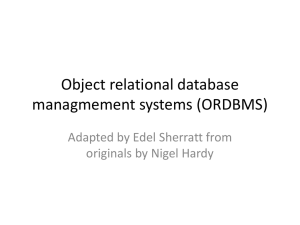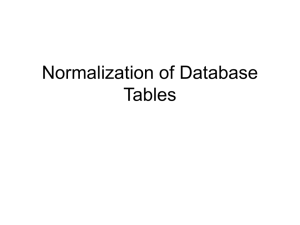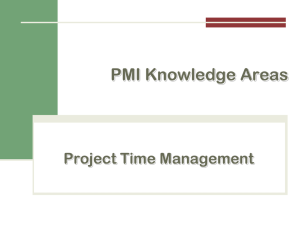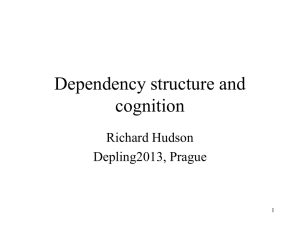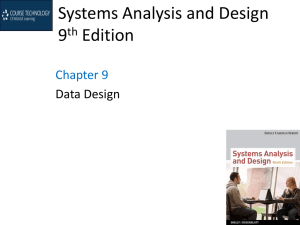Normalisation Example2
advertisement
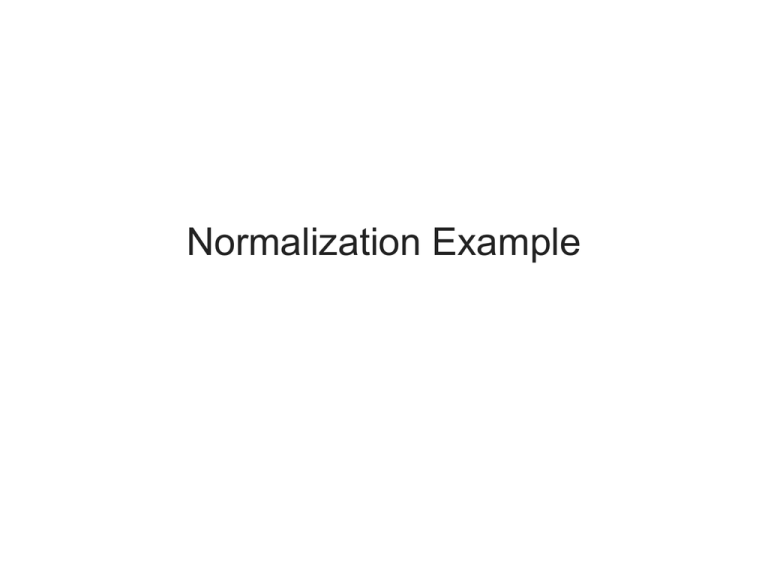
Normalization Example Database Tables and Normalization • Normalization – Process for evaluating and correcting table structures to minimize data redundancies • Reduces data anomalies – Works through a series of stages called normal forms: • First normal form (1NF) • Second normal form (2NF) • Third normal form (3NF) Database Systems, 8th Edition 2 Normal Forms: Review • • • • Unnormalized – There are multivalued attributes or repeating groups 1 NF – No multivalued attributes or repeating groups. 2 NF – 1 NF plus no partial dependencies 3 NF – 2 NF plus no transitive dependencies Database Tables and Normalization (continued) • Normalization (continued) – 2NF is better than 1NF; 3NF is better than 2NF – For most business database design purposes, 3NF is as high as needed in normalization – Highest level of normalization is not always most desirable Database Systems, 8th Edition 4 5 The Normalization Process • Each table represents a single subject • No data item will be unnecessarily stored in more than one table • All attributes in a table are dependent on the primary key • Each table void of insertion, update, deletion anomalies Database Systems, 8th Edition 6 Conversion to First Normal Form • Repeating group – Group of multiple entries of same type exist for any single key attribute occurrence • Relational table must not contain repeating groups • Normalizing table structure will reduce data redundancies • Normalization is three-step procedure Database Systems, 8th Edition 7 Conversion to First Normal Form (continued) • Step 1: Eliminate the Repeating Groups – Eliminate nulls: each repeating group attribute contains an appropriate data value • Step 2: Identify the Primary Key – Must uniquely identify attribute value – New key must be composed • Step 3: Identify All Dependencies – Dependencies depicted with a diagram Database Systems, 8th Edition 8 Conversion to Second Normal Form • Step 1: Write Each Key Component on a Separate Line – Write each key component on separate line, then write original (composite) key on last line – Each component will become key in new table • Step 2: Assign Corresponding Dependent Attributes – Determine those attributes that are dependent on other attributes – At this point, most anomalies have been eliminated Database Systems, 8th Edition 9 Conversion to Second Normal Form (continued) • Table is in second normal form (2NF) when: – It is in 1NF and – It includes no partial dependencies: • No attribute is dependent on only portion of primary key Database Systems, 8th Edition 10 Partial Dependency • Partial Dependency – when an non-key attribute is determined by a part, but not the whole, of a COMPOSITE primary key. Partial Dependency CUSTOMER Cust_ID Name Order_ID 101 AT&T 1234 101 AT&T 156 125 Cisco 1250 Conversion to Third Normal Form • Step 1: Identify Each New Determinant – For every transitive dependency, write its determinant as PK for new table – Determinant: any attribute whose value determines other values within a row • Step 2: Identify the Dependent Attributes – Identify attributes dependent on each determinant identified in Step 1 • Identify dependency – Name table to reflect its contents and function Database Systems, 8th Edition 12 Conversion to Third Normal Form (continued) • Step 3: Remove the Dependent Attributes from Transitive Dependencies – Eliminate all dependent attributes in transitive relationship(s) from each of the tables – Draw new dependency diagram to show all tables defined in Steps 1–3 – Check new tables as well as tables modified in Step 3 • Each table has determinant • No table contains inappropriate dependencies Database Systems, 8th Edition 13 Conversion to Third Normal Form (continued) • A table is in third normal form (3NF) when both of the following are true: – It is in 2NF – It contains no transitive dependencies Database Systems, 8th Edition 14 Transitive Dependency • Transitive Dependency – when a non-key attribute determines another non-key attribute. Transitive Dependency EMPLOYEE Emp_ID F_Name L_Name Dept_ID Dept_Name 111 Mary Jones 1 Acct 122 Sarah Smith 2 Mktg You are given a spreadsheet that contains information about a private airline company that provides chartered flights to clients. The spreadsheet has been turned into 1NF by removing the repeating groups and choosing a composite primary key. You need to conduct normalization up to 3NF. 1NF: (CHAR_TRIP, CHAR_DATE, CHAR_CITY, CHAR_MILES, CUST_NUM, CUST_LNAME, CHAR_PAX, CHAR_CARGO, PILOT, COPILOT, FLT_ENGINEER, LOAD_MASTER, SEAT_NUMBER, MODEL_CODE, MODEL_SEATS, MODEL_CHG_MILE) What is the composite primary key? Now write down the partial dependencies and the transitive dependencies. 16 Partial Dependencies • CHAR_TRIP → CHAR_DATE, CHAR_CITY, CHAR_MILES, CHAR_PAX, CHAR_CARGO, PILOT, COPILOT, FLT_ENGINEER, LOAD_MASTER, MODEL_CODE, MODEL_SEATS, MODEL_CHG_MILE • CUST_NUM → CUST_LNAME • CHAR_TRIP, CUST_NUM → SEAT_NUMBER 17 Transitive Dependencies • MODEL_CODE → MODEL_SEATS, MODEL_CHG_MILE 18 Remove all partial dependencies to complete 2NF • CHARTER(CHAR_TRIP, CHAR_DATE, CHAR_CITY, CHAR_MILES, CHAR_PAX, CHAR_CARGO, PILOT, COPILOT, FLT_ENGINEER, LOAD_MASTER, MODEL_CODE, MODEL_SEATS, MODEL_CHG_MILE) • CUSTOMER(CUST_NUM , CUST_LNAME) • TICKET(CHAR_TRIP, CUST_NUM , SEAT_NUMBER) (Could also call bridge entity Charter Customer or Customer Charter) 19 Remove all Transitive dependencies to complete 3NF • CHARTER(CHAR_TRIP, CHAR_DATE, CHAR_CITY, CHAR_MILES, CHAR_PAX, CHAR_CARGO, PILOT, COPILOT, FLT_ENGINEER, LOAD_MASTER, MODEL_CODE) • MODEL(MODEL_CODE, MODEL_SEATS, MODEL_CHG_MILE) Note: CUSTOMER and TICKET table remains the same. Database Systems, 8th Edition 20


